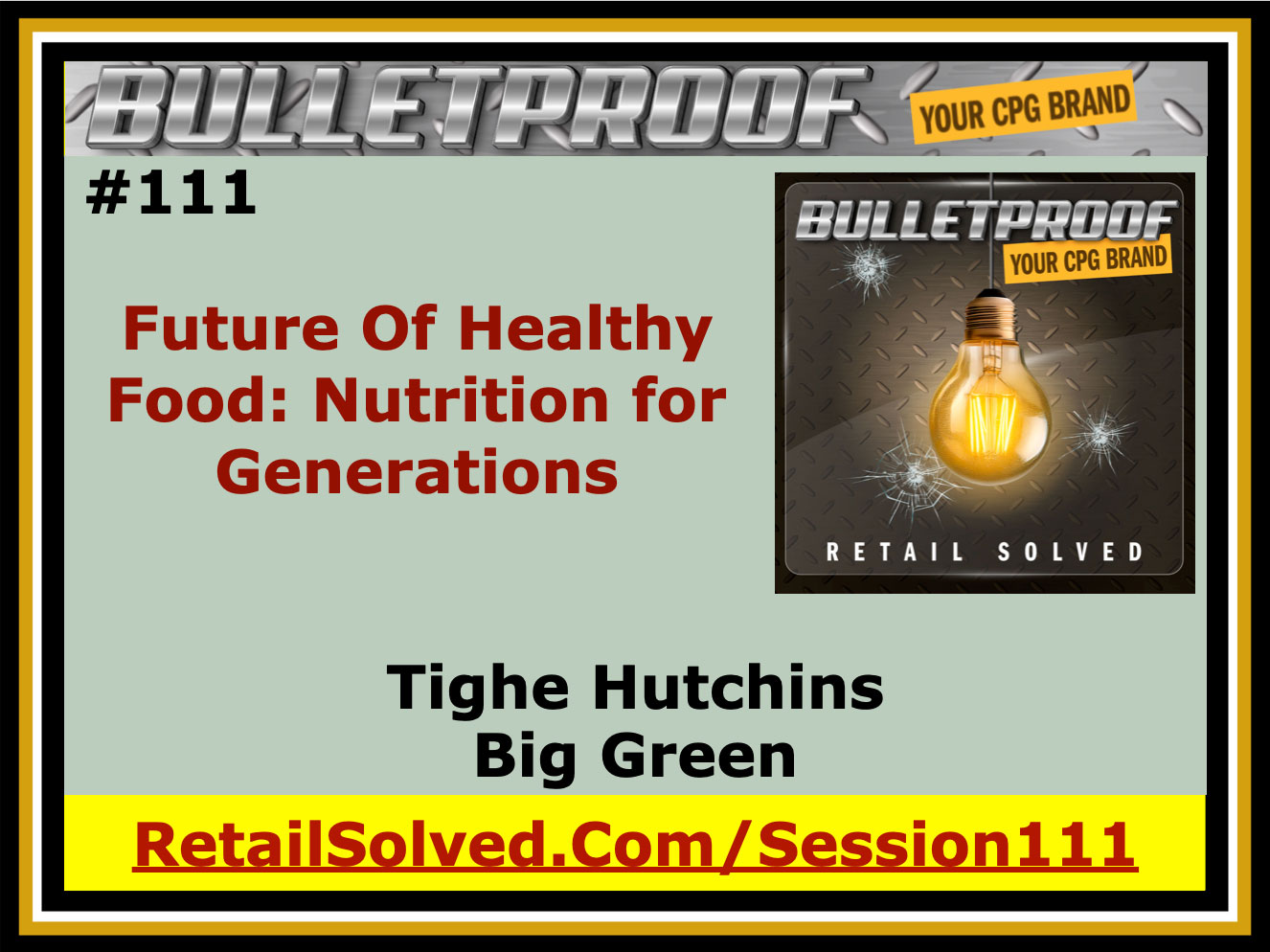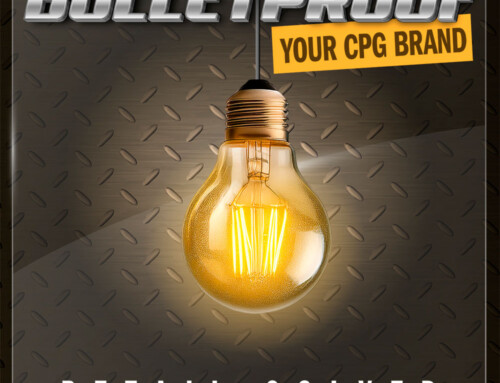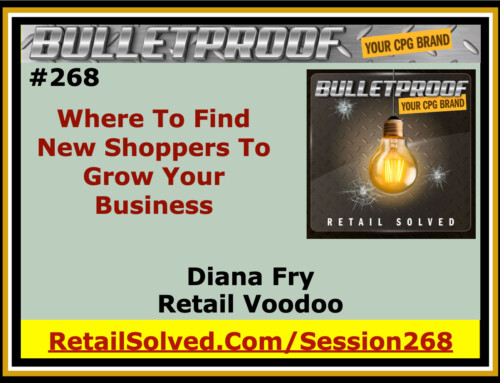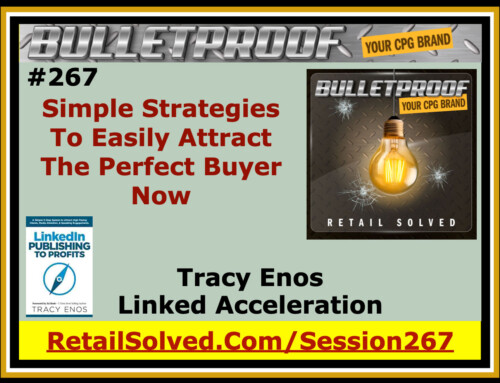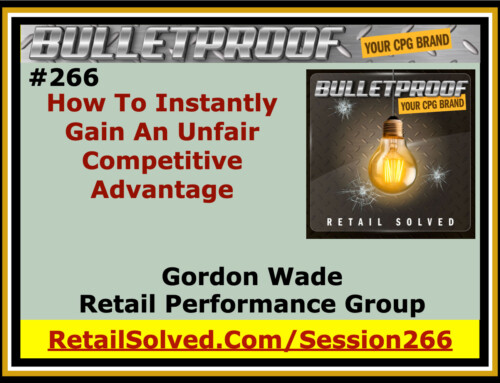Discover how the future of healthy food is shaping our industry and promoting better nutrition for everyone. Big Green aims to change how people think about food, starting with children. Through their Learning Garden program, they build outdoor gardens in underserved urban schools, fostering community engagement and teaching students about healthy eating and sustainable food practices.
The future of our industry is in the hands of our children. If you are what you eat then what you eat matters. Quality nutrition is the best preventative cure to many of the problems that plague us. Big Green is committed to Real Food For Everyone.
Click here to learn more about Big Green
Listen where you get your podcast
Important: Brand Secrets and Strategies has been rebranded to Retail Solved. Please swap all BrandSecretsandStrategies.com URL’s with RetailSolved.com. This is now the Bulletproof Your Brand podcast. Thank you for listening! BRAND SECRETS AND STRATEGIES PODCAST #111 Hello and thank you for joining us today. This is the Brand Secrets and Strategies Podcast #111 Welcome to the Brand Secrets and Strategies podcast where the focus is on empowering brands and raising the bar. I’m your host Dan Lohman. This weekly show is dedicated to getting your brand on the shelf and keeping it there. Get ready to learn actionable insights and strategic solutions to grow your brand and save you valuable time and money. LETS ROLL UP OUR SLEEVES AND GET STARTED! Dan: Welcome. Today's story is about inspiration. The lifeblood of every brand is the customers who buy their products. The survival of any brand is its ability to acquire new customers. Well, why not start where that matters the most? Why not start by teaching children about the value and the importance of quality nutrition? Why not start acquiring customers at an early age, and I don't mean marketing or doing something sleazy or something like that to try to attract these customers. What I'm talking about is an innovative mission to help teach the value of proper, healthy nutrition to young children and how that can be communicated to their parents. Be honest: think about how influential our children could be on our buying decisions. Wouldn't it be amazing if instead of having your child beg for the cereal with the new superhero on the cover, instead, wanting something that's healthy? Wanting more of products with ingredients that they grew at school themselves. Brands are continually looking for a mission to align themselves with, a mission that matters, something that resonates with their customers. Something that differentiates them from everyone else. Why not focus on a mission in your own backyard? Why not create a mission where you're educating and inspiring the community around you to love and appreciate food, especially the food that you're making? Today's story is about GreenSeed, a company that's committed to and dedicated to changing the way we think about food, beginning with our children. I love the story, and you're going to love it too. Nothing inspires me more than making a difference in our community. We rise by helping each other. I want to personally encourage everyone to check out Big Green, and to see for yourself firsthand, the difference that they're making. My call-to-action to you is to get involved and to help them achieve their mission, your mission, to help get your healthy products onto more retailer shelves and into the hands of more shoppers. One way to do that is to join the Plant a Seed Day movement on March 20th, 2019. You can learn more about it on their website. There's a link at the end of the show. Now here's Tighe Hutchins with Big Green. Tighe, thanks for coming on today. Can you start by please telling us a little bit about yourself? Tighe: Good, good to be on. My name is Tighe Hutchins, and I am the president of Big Green. I was a founding member of the team here. We were founded in 2011, and really over the past... man, 10 to 15 years, I have spent a lot of my work focused on working with communities to empower people to eat healthier and to learn more about where their food comes from, and also at Big Green, working to build more learning environments across the country. Dan: As I said when we started this, you've got such an impressive resume. Can you go a little bit more into it and talk about why does this matter to you? Why is this important, and then, why is your focus on trying to change the way or affect the way or improve the way people eat? Tighe: Sure. It's funny; when I talk about why this is important to me, it always takes me back to when I was a kid. When I was growing up, I was an athlete; I played lacrosse all the way through college. As an athlete, you spend a lot of time exerting energy. I really had no sense for how does energy contribute to how you feel every day. It was really more of a tool for me to able to get out and play sports. Then one summer when I was in my teenage years, I needed a job for the summer and was also training for lacrosse, and someone suggested that I go and work on a farm. I was very interested in environmental science at the time but had never planted or grew anything on my own throughout my entire life. So I went onto this farm and I got this summer job. I thought it was great; I could work from 7AM until noon, make some cash, get to be outside and get a good suntan, but then in the afternoon, I could go and train. I thought it was going to be a piece of cake. Well, if anyone that you know has worked on a farm or if you've ever worked on a farm before, it is not easy. I spent the first couple weeks with the sorest shoulders and hands, and I smelled like greens and dirt. It really wasn't education for me, but after the couple of weeks, I was really tired because it was a lot of work, and the farmer noticed. One day, she said to me, "Hey, come out to the field. I really want to show you something." So we walked through the field, through various spinach and tomatoes, and there's all kinds of things growing in the garden. We got to this strawberry, and when we got to the strawberry patch, the farmer, who was meticulous, takes out this beautiful strawberry and she said, "I want you to try this and tell me what you think." It was the first time that I had really picked anything off of something I had helped grow, and it completely changed my perspective on growing food as well as on what food tastes like when you put so much love and care into it. For me, the strawberry was amazing. It was so sugary and so much taste that came out of it. I can still remember it to this day, and for me that was really a pivotal point in my life when I really recognized what the power of food can not only do for your health but for your psyche, as well as for the prevention of long-term chronic illnesses and making sure that you are fueling your body with not just energy but actually with healthy, purposeful food. Dan: Thank you for sharing that. I love that story. Yeah, it is hard work, but to be able to see something that you've actually helped produce, that you've actually helped to grow. I used to love having a garden in the backyard. A little bit different, but the same idea where you can go in and grow everything that you are consuming, but going back to what you're talking about, when you taste something out of the ground that's planted in a way that's authentic, that doesn't have pesticides and herbicides, it tastes so much different, radically different than anything on a store shelf. As you're saying that, I'm thinking about a lot of the strawberries that I've had that I've bought from the store that don't really have any taste at all and they're kind of spongy, and there's nothing that really attracts you to wanting to eat them, so thanks for sharing that. So how did that equate to educating you about the power of food and the power of mindset? I like the way that you put that. Tighe: Sure. For me, I am the type of person, the type of thinker that really has to experience it to believe in it and really enjoys getting my hands dirty in the work that I really care about. After that experience that I just referenced, I really spent a lot of time looking at primarily the food system around where does and also, how are kids learning about where their food comes from? When I started looking at this, I started to recognize the problem that is going on in this country today that I would very much say that I was a part of. Not knowing what a strawberry tastes off the vine until I was 17 or 18 years old is not something that we want all of our kids to grow up waiting that long, to know where their food comes from. I started looking at this across the country and saw that in specific communities and at Big Green, we know as a community that we work in, 40% of kids are showing up in kindergarten obese or overweight. That statistic encouraged me to really try and think about a scalable system for a solution, and that is really what, at Big Green, we focus on here and is what Kimbal Musk, my co-founder and I, really tried to spread the word about, is that this is a huge problem and we want a scalable system to be able to create this solution. That is where Big Green was really founded and has built our work on the past seven years. Dan: Love it. Okay, so let's back up a little bit, and this is exactly why I wanted to have you on the show, so thank you so much. I met you at Natchcom; you were a speaker there, and I was so thoroughly impressed with your story and what you were sharing. Essentially a smaller version of what you just shared, more the corporate view, and what I mean by that, you didn't into the weeds and talk about, not literally, but talk about what impacted you or what changed you or what made you think about this differently, and so the strawberry story really resonates. If you are what you eat, then what you eat matters. What I mean by that, and I say that a lot, is that understanding nutrition and if you get the best nutrition to fuel your body, then you have the energy to do other things, not just do things but think more clearly and be more vibrant, et cetera. With that in mind, the thing that I really appreciate about your conversation, what you shared, your presentation was that you're teaching young people the value of food, and then you're walking the walk and talking the talk, and in terms of the mission you guys have, you're also going out there and making a sustainable difference. Why this is important is because people align themselves with brands that are mission-focused, and a lot of the brands that listen to this podcast are mission-focused, first of all. Then secondly, I'm trying to help them understand how do they communicate the value of their products inside of their package to their end consumer. Going back to what you just said, this is why this matters; helping someone understand that there's a really big difference between a strawberry that you pick out of a field that's fresh, organic, et cetera, than something you buy on a store shelf and being able to communicate that to your end consumer. So, how did you get started with this? How did you get connected with Kimbal Musk, and then what caused you guys to want to take this to the next level? Tighe: Sure. I got started with this back in 2011. Kimbal Musk had a vision for school gardens. School gardens have been around for a very long time, and there are many successful models that are out there that we studied when I first started talking with Kimbal about this idea, but what we didn't see out there was a model that was scalable and could fit into any type of school yard, whether that be a school with 10,000 square feet of green space or a school with just 500 square feet of green space. We really felt like we needed to come up with a solution for that. That really was driven by Kimbal; I joined him after he and his wife, at the time, had come up with this idea of the Learning Garden, which is actually a product that was designed to bring the school garden to the 21st century in terms of making it a space where people really wanted to be in and making it a space where it was really easy to grow fresh fruits and vegetables, and that teachers would want to come out and actually teach in. This product that we developed, it's a rotationally molded product that we work into our schools and we use landscape architects here on staff to actually design it so it is a beautiful outdoor classroom. In 2011, we started working in Denver, Colorado and worked at one school to really test this idea of, "Can we bring school gardens to the 21st century from the viewpoint of a very cool, fun product that allows teachers to be able to teach throughout the day, whether it be science, math?" We focus a lot on health and nutrition, and also be able to grow fruits and vegetables so that kids can have that experience, so that they can taste that strawberry just like I did years ago. We immediately had buy-in; we had the governor out to the school, we had the school district saying, "Yes, can we have more of these?" That immediate buy-in really helped us to come up with a model where we don't just build one garden; we actually partner with the school district to build up to 100 school sites throughout each city we work in. Dan: Wow, that's great. Let's step back a little bit. I remember seeing the video that you shared during the presentation. Can you please explain this or kind of visually paint a picture in our mind what that looks like, why it's important? I'm trying to think how I want to put this. It's somewhat modular in the sense that it looks like all the gardens fit neatly together, but yet you do it- Tighe: Mm-hmm (affirmative). Dan: In such a way that's very aesthetically pleasing, that's very comfortable, and it's very peaceful. One of the things I like about it was that it was an opportunity, from the video you shared, for students to get away from the noise, the clutter, the playground, et cetera, and immerse themselves completely in that setting. Tighe: Sure. So the gardens and the students in the gardens, when we select a school to get a Learning Garden, the school goes through an application process and works with us to make sure that they have a vision for their garden. Part of that vision very much involves the students' involvement. When the students come to school on what we call our "Kickoff Day," it's the very first day when the students actually help build the garden. What they see is a, to give a visual image, an empty dance floor. We set the stage for the students to actually help build the garden, and we do that so that they have the buy-in, they have the ownership of the actual space. Throughout the day on that Kickoff Day, they help put together the garden. What the garden actually is is it's 12 pieces that get fit together, like you were saying. They're actually raised white garden beds; they are about 18 inches tall so that they are very easy for the students to work in without the teachers having to bend over or be on their knees. They fit together kind of like building blocks, so you can design them so that it's an outdoor classroom space, but it also has a very modular approach to it where the garden actually has somewhat of a rhythm to it and really nice curves to it. We also do this because all of our gardens are ADA accessible, so any student can come in and actually use the garden. Throughout the day, the students help put it together; they help put the soil into the garden, we have benches in the garden, we have a shade structure that goes up into the garden. At the end of the day, our garden educators that work with our students knight the students as the guardians of the garden. We do this very purposefully. We do this because we believe that each student, in order to really have that buy-in, to really believe that they can grow something needs to feel responsible for it. Making them a guardian, they then serve as a role of making sure that this garden is taken care of, that things are respected in that space, that kids can come out and read and enjoy themselves in the space, and that they're going to grow things and they are actually going to watch over those plants as they grow. It's a full school experience, but the actual product and the actual space that we bring to the table is quite unique, like you were saying. Dan: I think it's great. Again, if anyone has a chance, please go to your website. I'll certainly put a link in the podcast webpage and in the show notes to it, but what a great concept. I absolutely love the fact that you get the school and, more importantly, the students to buy into this. Not only into the idea of, "Hey, we're going to plant something" and do the whole idea of the garden and taking responsibility for it. I think that's at the core of everything we do, and I say this kind of flippantly, but if people don't eat organic or healthier products, there's no purpose for having them. The reality is that consumers want healthier products. They want to understand what's in the package and the look beyond the four corners of the package. To be able to teach someone, especially young people, why that's important and why that matters, because you got to know that that then gets transferred through the storytelling that they have with their families and how much that would impact their overall family health. Let's back up a little bit. So if someone is approved for a garden, then does that include everything with the garden, or how much support do you get from the school and from the community to build these? Tighe: It's a great question. We work as an organization to be able to provide the full Learning Garden to the school, but the only way that we can do that is by getting the school to commit to providing the time, the space, and the energy to using the garden in an impactful way. That school actually raising that hand and saying that they want to fill out an application and that they want to have a new outdoor classroom on their school site. After they fill out the application, the school is responsible for coming up with the garden team, and that garden team usually consists of parents, community members, teachers, and sometimes students depending on the age range of the school. That is really the pivotal piece that brings those different aspects together and allows a space where the outdoor classroom then becomes something that is of shared value for not just the teachers but also those that are around the school, such as the parents, the community members, as well as the administration. Dan: Great. That's so important to have the community buy into this. I keep saying that what makes "natural" natural is the fact that we have a community, the fact that we're all working toward a common goal. My mission, for example, is to make a healthy way of life more accessible by getting your products onto more retailer shelves and in the hands of more shoppers. Granted, you're not necessarily a product. You are, but not in the sense that I normally talk about, but yet helping consumers understand why that community's important and how that community's ultimately going to change the way that we as a nation deal with food or we think about food. I was talking to Gary Hirshberg about this and he was saying we vote with our dollars, and the whole idea was that it's smarter to put good food into your body, and it's cheaper too, rather than to pay a doctor to clean up the mess that you made because you didn't take care of yourself all along, which ties back into what you were saying as an athlete. When I was an athlete, I consumed a lot of calories but they were healthy calories. I guess what I'm getting at is that if you are what you eat, teaching these kids at an early age why this matters at such a macro level. Can you talk a little bit more about what's involved in a school to really getting going on this? They fill out the application. How do they contact you? How would we send people your way? Tighe: The school fills out an application, and we actually work through the school district on that. I mentioned earlier that we focus exclusively on scales here at Big Green, and the way that we work to expand is we expand city by city. Instead of spreading our resources across the country to individual schools, we actually partner with school districts to then build those 100 school sites. The cities that we are in today are the Denver area, Chicago, Indianapolis, Pittsburgh, Memphis, Detroit, and Los Angeles, but we do have a goal to get to a thousand schools in ten cities in the next two years. We are rapidly expanding to partner with school districts so that then, we can offer the opportunity to those specific schools. We do primarily work in urban cities, and we also primarily are working with underserved communities. Dan: Is there a way that a brand could take on this mission to help get you in front of more school districts? Tighe: Absolutely. We would love to partner with more brands to get them more involved in the mission and our vision for expansion. One of the really exciting things that we did this fall was we had the University of Colorado Denver do a third-party evaluation of our Learning Garden. What the university found was that first and foremost, when students are in our Learning Garden and learning about fruits and vegetables, they're twice as likely to eat those fruits and vegetables in the lunchroom and at home, but then what they also found was that students were going home and they were advocating to their parents for more healthier options, and they were doing that by going to the grocery store with them, by cooking meals with them, by bringing them to the Learning Garden. So the value of our kids learning about where their food is coming from is really expanding to that awareness and that advocacy piece with families and communities. When we look at going into a new city, we look at partnerships to help us get there, whether it be through financial support or it be through introductions, or it be through a partnership where we are trying to really figure out what is the best pathway for us to build a hundred gardens. Dan: This is exactly, again, why I wanted to have you on the show, so thank you because this is where it begins. If we can teach young people the value of food, and going back to your strawberry story, if we're eating strawberries from a store and they don't taste very good, they don't have the texture, they're not sweet, they don't really appeal to you whereas having the strawberry that you had on that particular day, that's the opportunity to really teach, educate, and motivate people. I liken this to be the ripple in the pond; if you can get people engaged at that early age and at that early stage in a product's development by teaching them the value of quality food, that's how we increase or grow awareness in the natural community, and that's how we fix things like obesity and a lot of the other problems that we're facing. Thank you for doing that. How are you guys doing in terms of reaching your goals? I mean, is this a super overreaching goal, or is this something that we, through this podcast, can help support? Tighe: We are doing very well on our goal, but we also still need a lot of help. To date, we have about 550 school sites that we work with across the country. That is about 300,000 students every day that come into a school with a Learning Garden. That rapid growth, in 2011 like I was mentioning before, we had one Learning Garden in Denver Public Schools. After we built the first one, Denver Public Schools asked us to build more, and so we expanded in Denver Public Schools, and then Chicago Public Schools heard about what we were doing and they asked us to come and help build Learning Gardens in Chicago Public Schools. We built over a hundred Learning Garden school sites in Chicago in one year, I believe it was in 2013, because there was so much demand. Dan: Great. Tighe: We have been incredibly successful on being able to partner with the school district and the cities to implement our program, but now, what we really need help with is going from seven cities, which is where we are right now, to getting to that ten-city number. We are actively looking for partners to help us do that. We actually have a challenge going on right now called "the Get Growing Challenge" where the whole point of it is to help us get to those 10 cities by 2020. Dan: What does it look like, who does that include, and how do we get involved? Tighe: The Get Growing Challenge is a new challenge that we have just put together. It is a national partnership that we are working with companies to partner alongside of us to help go into new cities. What we really need is to start those conversations with those companies around what do they want their employees to work on with Big Green, what types of cities do they want us to work in, as well as how can we make more impact for our kids, and obviously that's the most important part, is that impact. For anyone to get involved, Big Green would love to have those discussions with any company that is looking at having more impact within their organizations. Dan: I want to help support this. This is great, and so I hope that through the podcast we can start doing this or getting it out. I'll be promoting it, of course. If we can certainly, and anyone listening, any brands listening, this is a unique opportunity to build new consumers at an early age. What I mean by that, if you think about the way that a lot of retailers do their merchandiser stores, they put the sugar cereals at eye level for kids. Well they do that for a reason, but that encourages the kid to say, "Oh, I recognize that," whoever on the box, "the tiger," et cetera to be able to buy that product. We're changing the mindset, changing the way that kids buy products. If we can influence and impact the way that kids think of food, then we can help impact and change the way that adults think of food, which helps every brand listening to this podcast. I really want to encourage everyone who's listening to seriously consider this as an opportunity to engage people at a much different level. Again, it's about, like you said, building community around it. Getting the parents, the teachers, the community, and the kids to buy in on this idea that healthy products are better for you. What's really cool about this, going back to the idea that people look beyond the four corners of the package, if you're trying to understand what a strawberry looks like or tastes like and it's written on a package, this is an opportunity for you firsthand to try to sample, to get used to that product, to learn how to make it, plant it and grow it, et cetera, but this is where it starts, at the very, very granular level, so thank you for sharing that. Where can people reach out and connect with you and your team to help get started? Tighe: Biggreen.org is the best place and the easiest place, I think, to get started. On the website, you can find all the cities that we work in, more background about what we do, some fun videos that we have, and my contact information as well as anyone on our team's contact information lives there as well. Dan: On that note, you have a wealth of great information on the site, which again, I talk about brands needing to be able to build this into their selling story. This is the kind of information that they need to have. If a brand can figure out a way to leverage what you've got on your site in terms of, for example, you said that 40% of kids are obese or overweight, and talk about how a brand is solving that particular problem. That's part of the discussion that we need to be having. That's part of the discussion that brands need to be working on with retailers. This is why small, disruptive, natural/organic brands, et cetera are so very important to the retailer because they are responsible for driving sustainable sales across the entire store more so than their larger counterparts. Because of that, this is a unique opportunity for them to compete at a much higher level. To step back a little bit, what I'm getting at is that a consumer that goes in to buy an organic product, for example, is more likely to buy organic products in different categories, so that consumer, at the end when they check out of the store, their market basket's much higher, and as a result, that consumer's more valuable to the retailer than other consumers. Tying this back into what you're doing, that's why this matters. We've got to start teaching people why food matters, and more importantly, why healthy, natural/organic food matters. Do you have any other thoughts or anything else you want to share on that note? Tighe: I think that the other really exciting campaign that we are doing right now and is another really easy way for brands to think about how to get involved is on March 20th of 2019, we as an organization have a goal to get a million kids, families, parents, and Americans to plant a seed in the ground, in a cup on their windowsill, in a planter, anywhere they think a seed will grow to help spread awareness about what we are doing as well as get the conversation going around building a healthier future for kids, and this campaign is new this year but it could be a really great way for more brands to work on their awareness, and something that we'd love to talk with more brands about. Dan: Well, if I can help connect you with people, I'd love to. I'd be honored, and again, I love what you guys are doing. One of the things that I didn't talk about that I really wanted to share with you, I don't know if I told you this when I met with you, is that I was talking to Phil Lempert, the Supermarket Guru, several months ago. I think it was episode 32 or 42, something like that. Anyhow, he was talking to Kimbal Musk and how Kimbal was saying that, and I'm just paraphrasing, I know I'm saying this wrong, that food is the new Silicon Valley, and the whole idea behind that is this is where the emerging of new technologies and a lot of interests are. Think about it: people put more energy and more effort into figuring out which iPhone or which app to buy than they do the food that they're putting on their plate. That's changing, and because that's changing, this is what makes it so very relevant today. Do you have any comments? Any thoughts you want to throw in about that? Tighe: It's funny; we just were having lunch here at the office, and Kimbal and the team were talking about technology and how it's really exciting to see technology being utilized in food for good and being utilized in a way that is really changing the space and allowing for more individual brands, consumers to learn about where their food comes from, and also access food in a way that was not possible years ago. We really do believe, and Kimbal's vision for all of his companies is "Real Food For Everyone." Though technology, I think that food is definitely changing very quickly, and we're excited to be on the forefront of that with the Learning Garden program and being able to bring gardens at scale to many, many cities. Dan: Love what you're doing, and I can't thank you enough for coming on today. If there's anything else you can think of that you want to throw out there that you want to say, please do, Tighe. I'm just thrilled that you guys are doing what you're doing. A huge fan of what you guys are doing, and just making a change for good, so thank you for all you're doing and your team. Thank them as well, please. Tighe: Thank you. I love being on it, and we really do have an interest in connecting with brands that are looking for more mission alignment and are always happy to have those conversations, so if you come across some, please let me know. Dan: Well I'll certainly mention it a lot because it think that that's a real opportunity. Again, this is why I wanted to have you on the show. It's that ripple in the pond; we've got to start teaching people why food matters as early as possible. Going back to the strawberry example, if people were to eat like that all the time, they would eat less, first of all, they'd have more health, et cetera, but they'd be inspired by the food that they're putting in their mouth. I know Kimbal's got a restaurant in Boulder that I love going to every chance I get up there, but it's good, healthy, quality food. You know what's really amazing is that it really doesn't cost any more when you think about it than this processed stuff. Tighe: Mm-hmm (affirmative). Dan: In fact actually, you might get a kick out of this. I use this reference a lot. I mean a lot of natural/organic products are merchandised in the wrong section. Well if we can put those side-by-side with their mainstream counterparts, and so I use the bread example a lot: if you eat the cheap, generic bread, you're hungry almost by the time you finish eating it, but if you eat the best mainstream bread that's out there, you might be sustained for a couple hours. Well for a few pennies more, if you eat the natural/organic bread, you're sustained for maybe an hour or two longer. Over time, it's actually cheaper to buy the better product than it is to buy the mainstream product, and the point is that one of the things I think that we don't do well as a natural community is educate consumers on the value of the product; in other words, again, that if you're eating natural/organic products, if you are what you eat and what you eat matters, spending a little bit more at the shelf is going to save you tremendously in the long run. Then when you throw in all the things to consider like the health cost because you didn't eat properly, et cetera, those are the things that certainly complicate that or change that equation even more. Anyhow, thank you so much for your time. Huge fan of what you're doing, and thank you. Tighe: Yeah, thank you. Sounds great, and looking forward to being in touch again soon. Dan: I'd like to thank Tighe for coming on today and for sharing her story, and more important, for what she and her team are doing to change the way that people, especially young people, think about food. This is so very important; in fact, this is the future of our food. This is the future of the natural channel. I'll put a link to Big Green in the podcast show notes and on the podcast webpage. This week's free downloadable guide is "The Essential New Item Checklist: The Recipe For Success." This is where you learn how to use the strategies we talked about in today's podcast to help get your product on more retailer shelves and into the hands of more shoppers. You can get it, along with today's show notes, at brandsecretsandstrategies.com/session111. As always, I appreciate your listening and I look forward to seeing you in the next episode. Big Green https://biggreen.org This episode's FREE downloadable guide New product innovation is the lifeblood of every brand. New products fuel sustainable growth, attracts new shoppers, and increases brand awareness. Know the critical steps to get your product on more retailer’s shelves and into the hands of more shoppers. CLICK HERE TO DOWNLOAD YOUR FREE STRATEGIC GUIDE: The Essential New Item Checklist - The Recipe For Success Thanks again for joining us today. Make sure to stop over at brandsecretsandstrategies.com for the show notes along with more great brand building articles and resources. Check out my free course Turnkey Sales Story Strategies, your roadmap to success. You can find that on my website or at TurnkeySalesStoryStrategies.com/growsales. Please subscribe to the podcast, leave a review, and recommend it to your friends and colleagues. Sign up today on my website so you don’t miss out on actionable insights and strategic solutions to grow your brand and save you valuable time and money. I appreciate all the positive feedback. Keep your suggestions coming. Until next time, this is Dan Lohman with Brand Secrets and Strategies where the focus is on empowering brands and raising the bar.
Enter your name and email address below and I'll send you periodic brand building advice, tips and strategies.
Sign up to receive email updates
FREE Trade Promotion ROI Calculator:
Click Here To Maximize Sales And Profits
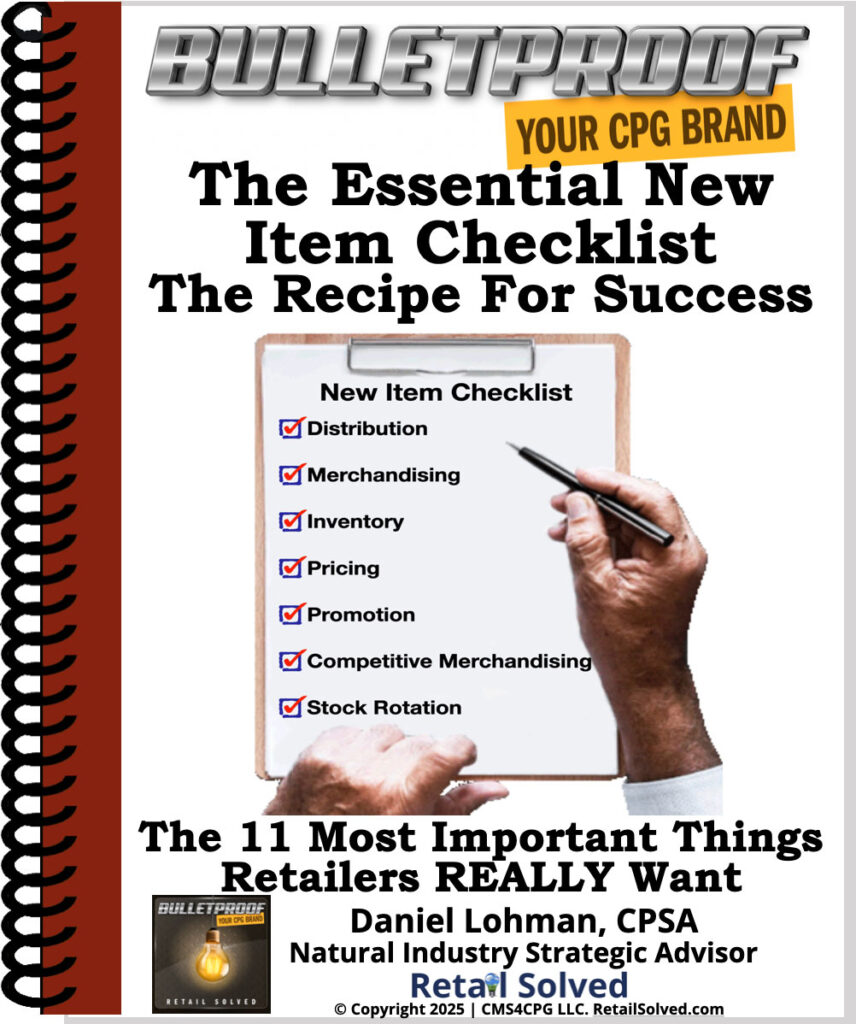
The Essential New Item Checklist – The Recipe For Success
Want A Competitive Edge? The Recipe For Success
New product innovation is the lifeblood of every brand. New products fuel sustainable growth, attract new shoppers and increase brand awareness. Learn the critical steps to get your product on more retailer’s shelves and into the hands of more shoppers. Maximizing your trade marketing can pour rocket fuel on your launch.
Image is the property of CMS4CPG LLC, distribution or reproduction is expressively prohibited.
